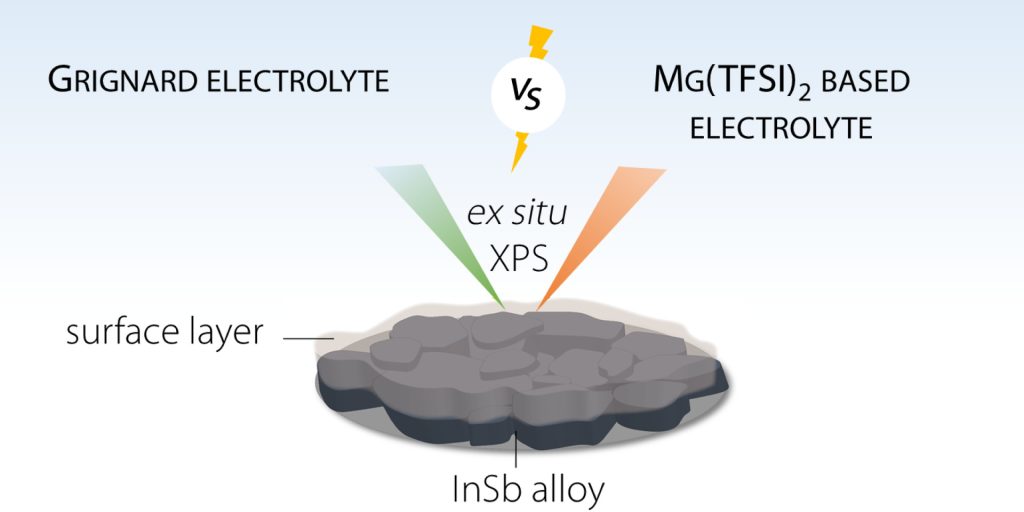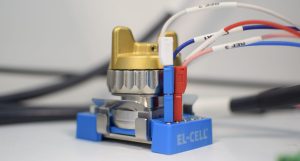The battery research group at LEEL investigates physicochemical and mechanistic processes occurring at the interface and in the bulk of post-Li-ion batteries to create a fundamental understanding.
Our research mainly focuses on developing a fundamental understanding of the various processes taking place in the electrode and electrolyte by developing various in-situ/operando characterization techniques. The aim is to build a knowledge base on the reaction mechanism, diffusion process, and interfacial properties in post-Li-ion batteries, especially aqueous batteries and solid-state batteries.
Magnesium and Aqueous Batteries
The development of lithium-ion batteries has played a key role in this development of intermittent renewable energies and mobile technologies. However, this technology seems to be reaching its limits and new solutions are emerging, such as magnesium batteries. Magnesium metal is an attractive negative electrode because of its abundance and its high volumetric and gravimetric capacities combined with a quite low redox potential. The divalent nature of Mg2+ offers two electrons per metal compared with just one in the case of alkali metals such as Li and Na.

The operation of a Mg battery is similar to that of a Li-ion battery, involving the exchange of Mg2+ ions between a positive electrode and a negative electrode, ideally magnesium metal, via an electrolyte solution. The main obstacle to making magnesium batteries is the lack of suitable electrolytes with a wide potential window that can be combined with magnesium metal or effective negative electrodes. At LEEL, we are tackling these challenges with two different approaches. One of the solutions is to replace the Mg metal at the negative electrode with compounds that form an alloy with the Mg and are stable to conventional electrolytes. This has been investigated within the MAGICIEN ANR project (2017-2021). Our second approach is to focus on the development of new electrolytes, particularly with the concept of concentrated aqueous electrolytes for Mg-ion batteries, in the frame of the MAGWAT ANR project.
Solid-State Batteries
Solid-state batteries are considered as the next-generation battery technology with many potential improvements over the current state-of-the-art Li-ion in terms of safety, power, and energy density. The development of efficient, high ionic conductive solid electrolytes is crucial for the progress in solid-state batteries. Low-cost synthesis and their optimization with different battery electrodes is seen as a decisive factor. Towards this direction, researchers at LEEL work on two important advanced electrolyte categories: ceramic and polymer-ceramic composite electrolytes.
Ceramic solid electrolytes: Our group has been active in developing new solid electrolytes for lithium and sodium solid-state batteries. We concentrate on the synthesis, structural characterization, and battery application studies of garnet, NASICON, and halide solid electrolytes.
Oxides (Garnet/NASICON) possess good electrochemical/chemical stability windows (above 5V) which makes them interesting candidates to be coupled with high-voltage cathode materials. Similarly, recently revisited halide ionic conductors have been applied in advanced high-voltage solid-state batteries. The electrode kinetics of solid electrolytes play a crucial role in various solid-state electrochemical applications including batteries. We aim to understand the effect of synthesis conditions, doping, and lithium concentrations on the ionic motion (diffusion) within the structure and the ionic conductivity of various solid electrolytes. By combining EIS impedance spectroscopy, NMR measurements, neutron diffraction, and ion beam analyses, we can identify links between formulation, structure, and ionic transport. In other words, we try to understand the movement of ions in the electrolyte and electrode, and how we can influence their activation energy barrier and stability by carefully modifying the structure by doping or by changing the synthesis conditions. In addition, a major focus of the research is to employ this newly developed electrolyte in various electrode composites (NMC, LFP, Sulfur, and Silicon) and study their electrochemical performances.
Polymer-ceramic composite electrolytes: Polymer electrolytes enable the application of lithium metal anodes in solid-state batteries, potentially hindering the dendrite growth and short circuits. They also enable enhanced safety, processability, adhesion to the electrodes, and flexibility. The currently used PEO-based polymer electrolytes require a high working temperature in the range of 60-80 °C for their nominal performance. Our research focuses on the inclusion of oxide and nasicon ceramic solid electrolytes in the polymer matrix to improve their ionic conductivity and reduce the operating temperature. Besides a further understanding of the charge transport mechanism in these electrolyte systems and the processes taking place at the interface with the metallic anode with EIS and solid-state NMR studies, our work particularly focused on increasing the ceramic content in the polymer matrix.
On-going projects on batteries





